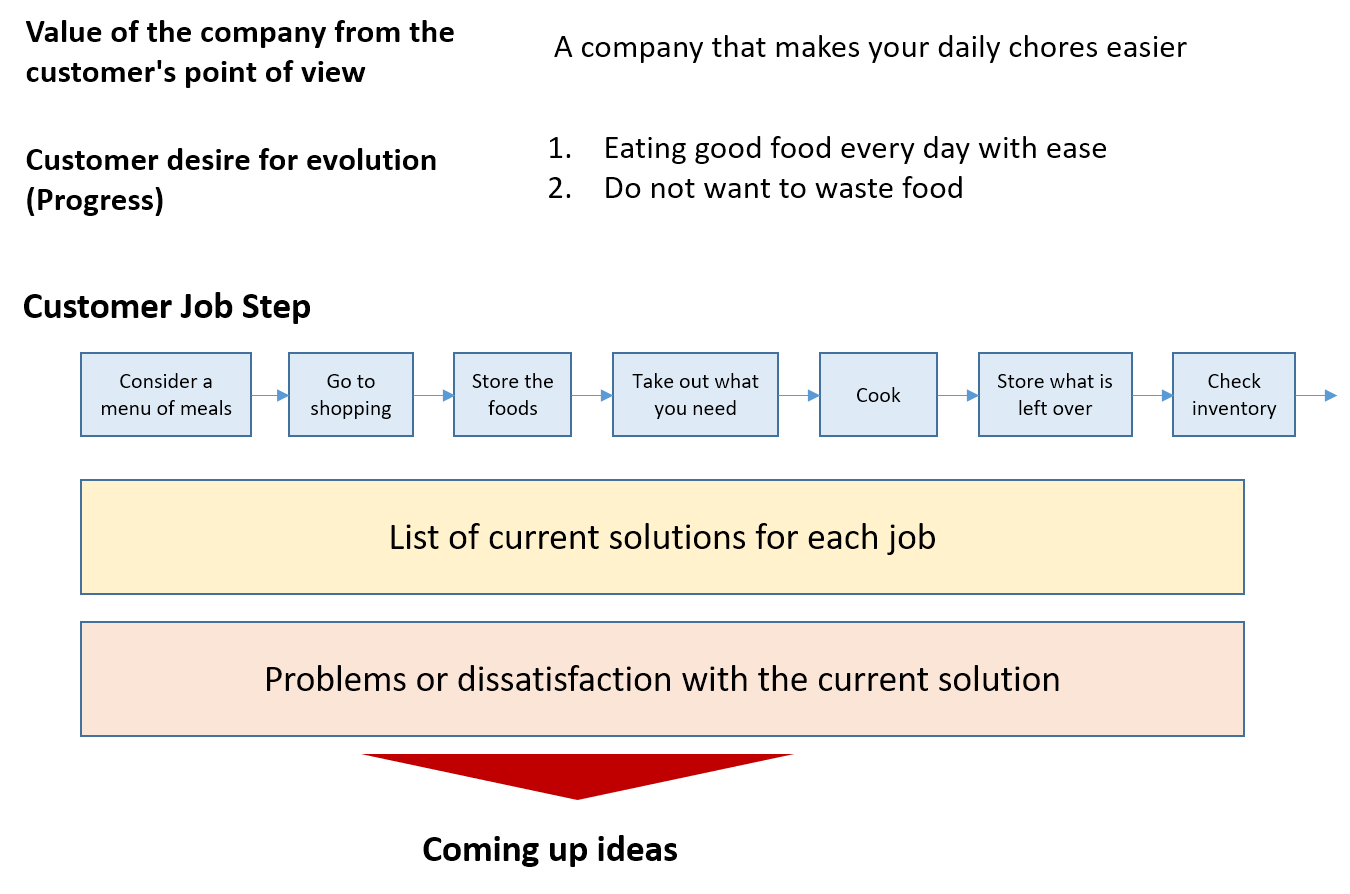
If you can grasp the latent needs of your customers in product planning or product development, and come up with a product that meets those latent needs, the chances of it becoming a hit product are much higher.
However, it may be extremely difficult to find latent needs that even the customers themselves are not aware of.
In this article, I will introduce three methods of finding latent customer needs, but the key to any of them is customer behavior.
In all of these methods, the key is customer behavior. You can discover latent needs by imagining, predicting, and actually observing customer behavior.
We recommend the following three methods to find latent needs.
- Design Thinking
- Job Theory
- Job Theory + Story Thinking
We will explain how to find latent needs in a simple and easy to understand way.
Contents of this article
How to find latent needs through design thinking

Design Thinking is said to have originally originated from literature on design engineering and design research, but today, Design Thinking is seen as an approach to utilizing the thinking methods of design to solve problems in business.
The first person to apply design thinking to business was David Kelley of Stanford University, who founded the design consultancy IDEO, and from there design thinking spread.
In a narrow sense, design thinking is about finding essential needs that users are not even aware of, and creating innovation.
In other words, it is a method of finding latent needs.
For the process of design thinking, the “Five Stages of Design Thinking” proposed by Professor Plattner of Harvard University can be used as a reference.
- Empathy
Understanding and empathizing with the user is the most important part. It is not just about being customer-oriented, but also about becoming the user thoroughly until you are able to feel the user’s emotions without taking the user’s word for it. - Definition
Pursue essential and latent issues on the assumption that users themselves do not understand the real issues. - Conceptualization
Extract ideas for the defined issues through brainstorming. - Prototype
The ideas that are generated are put into practice. - Testing
Put the prototype on the market, get feedback from customers, and test to see if it is really what the customers want.
Prototyping and testing in sections 4 and 5 differ depending on the business domain, product domain, etc., so I will focus on sections 1-3, i.e., empathy, definition, and conceptualization.
In particular, there are many characteristics of design thinking in the areas of empathy and definition.
In the book “Design of Action” by Chiaki Murata, he says that we should consider the customer’s action as a series of things, or a story, and find the bugs (problems) in the action or behavior.
A bug in action is when a customer is really dissatisfied with something, i.e., they have given up and accepted something that is problematic, but the action still shows unnaturalness, i.e., the bug is in action, and the real issue is found in the customer’s unnatural behavior.
Obvious dissatisfaction is something that everyone talks about, but you can find something that the customer doesn’t talk about but has implicitly accepted, but which is really a challenge.
Let me give you an example. Imagine going to a convenience store on a rainy day with a plastic umbrella.
Imagine yourself somehow hesitating to put the umbrella, which does not have your name written on it and is difficult to distinguish from the plastic umbrellas that everyone else has, into the umbrella stand placed at the entrance of the convenience store.
What would you do?
The person who does not put it in the umbrella stand, but leaves it lying on the side of the stand.
You would keep it at the end of the umbrella stand, away from other umbrellas.
People who give up on putting them in the umbrella stand and bring them into the store.
People who make marks with their own belongings.
What do you think? There may be many different people.
On the other hand, not many people complain to convenience stores that they should do something because they can’t distinguish between umbrellas, right?
That’s right. Many people accept this inconvenience, put up with it, and deal with it in their own way.
The discovery of latent needs through design thinking is to find the issues in such casual customer behavior.
Thinking about this kind of thing is called empathy and definition.
Now, conceptualization, or idea generation, for the defined problem can be done by brainstorming, KJ method, NM method, etc., but this is really a game of ideas for the team members.
When you take a break in a sauna, there is a pair of number tags and numbered clips where you can hang your wet towel.
This is an example of analogical thinking, the NM method of borrowing ideas from other areas.
How to find latent needs through job theory

Since the publication of Harvard Business School Professor Christensen’s “Job Theory” in Japan, Job Theory has begun to be used as a new marketing method in Japan.
In a nutshell, Job Theory defines the customer’s motivation for purchasing a product based on the idea that customers do not buy a product based on the product itself, but rather they adopt a product in order to get their “Jobs to be done” done.
For more information on Job Theory, please refer to the following article we published.
Use well two types of job theory
Teaches a framework for putting job theory into practice
What is Job Theory – a simple explanation of how to put it into practice
For a concise and easy to understand explanation of Job Theory, the examples used by Christensen are helpful.
A fast food restaurant in the U.S. (probably McDonald’s) conducts a marketing survey to try to increase sales of milkshakes. They analyze their customers’ demographics, their favorite flavors, cup size, shape, etc., and try out a new product, but the sales do not change at all.
Then, another team visually observes the customers buying milkshakes in front of the store all day long.
After keeping detailed records of what time they were there, what they were wearing, and what else they were buying, they found that one peak time was before 8:00 a.m., and that the people who were buying were lone businessmen in suits who bought only milkshakes, drove quickly to the store, and left quickly.
The next day, we interviewed the people who bought the milkshakes to find out what they were doing to get things done, or if they had bought something else before in the same situation.
What we find is that businessmen who drive to work in the U.S. find milkshakes to be the most comfortable way to satisfy the boredom of their hour-long commute.
With coffee, they finish it quickly.
Bananas are difficult to peel, and they are quickly eaten.
Bagels are tasteless. It’s hard to eat something with it while driving.
Chocolate makes me feel guilty after I eat it.
Milkshakes are too sticky and it takes more than 20 minutes to finish them.
It satisfies my stomach reasonably well and I can hold it in one hand.
In other words, it will take care of the “commuting time boredom” business most successfully than other competitors such as coffee, banana, etc.
It tells us that the competition for milkshakes is not always other companies’ milkshakes.
In other words, if you have the right view of the customer’s job, you will find the right solution for that job, and you will also find the right competitor for that job.
Getting the job itself right is a clue to discovering potential needs.
Job theory + story thinking to find latent needs

The method we recommend most for finding latent needs is a combination of job theory and story thinking.
Jobs, or things that customers need to get done (Jobs to be done), are connected by stories.
For example, imagine a video stream of the daily life of mothers with three-year-old children.
She puts her child in a stroller and goes out to buy groceries.
She walks to the nearest one and takes the train to a department store in the next town.
There are stairs at the station, and when you try to take the elevator up, it’s not working because it’s being inspected.
On the train, you have to be careful not to disturb people with your stroller when the train is crowded.
The stroller and the luggage I bought at the department store made things a bit difficult.
This is a way of finding latent needs by combining job theory and story thinking, where the customer’s problems at the time are imagined and new solutions are devised by considering what the customer needs to do as a story.
Our company recommends a framework to further develop this process, to think about the customer’s desire for evolution, a higher level of desire, and to think about how to improve the job story to satisfy the customer’s desire.

The figure above shows a framework in which a job story is extracted from the daily life of a housewife who does housework, and the customer’s high-level desire is to eat delicious food easily every day.
Furthermore, by connecting the customer’s high level of desire with the company’s mission, that is, the company’s value from the customer’s point of view, the company’s mission, the customer’s desire, and the new product idea are connected, leading to an improved brand image.
I think this is a way to incorporate marketing thinking while finding potential needs and connect them to brand strategy.
If you are interested in learning more about how to use job theory or how to incorporate job theory and story thinking, please contact us.

